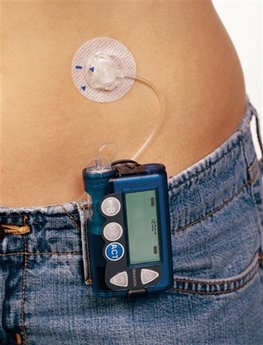Insulin pumps linked to injuries, deaths in teens
(Agencies)
Updated: 2008-05-06 15:13
Updated: 2008-05-06 15:13
CHICAGO - Insulin pumps are used by tens of thousands of teenagers worldwide with Type 1 diabetes, but they can be risky and have been linked to injuries and even deaths, a review by federal regulators finds.
 A photo provided by Medtronics Diabetes, shows a Medtronic Paradigm REAL-Time System insulin pump as it would be worn to allow young people to live more normal lives by giving themselves insulin discreetly in public. [Agencies]
|
Parents should be vigilant in watching their children's use of the pumps, researchers from the Food and Drug Administration wrote. They didn't advise against using the devices. But they called for more study to address safety concerns in teens and even younger children who use the popular pumps.
The federal review of use by young people over a decade found 13 deaths and more than 1,500 injuries connected with the pumps. At times, the devices malfunctioned, but other times, teens were careless or took risks, the study authors wrote.
Some teens didn't know how to use the pumps correctly, dropped them or didn't take good care of them. There were two possible suicide attempts by teens who gave themselves too much insulin, according to the analysis.
"The FDA takes pediatric deaths seriously," said the agency's Dr. Judith Cope, lead author of the analysis. "Parental oversight and involvement are important. Certainly teenagers don't always consider the consequences."
The pumps are popular because they allow young people to live more normal lives, giving themselves insulin discreetly in public and getting pizza with friends late at night. And they're a growing segment of diabetes care, with $1.3 billion in annual sales worldwide, said Kelly Close, a San Francisco-based editor of a patient newsletter. She said 100,000 teenagers may be using them.
The pumps are used for those with Type 1 diabetes, which accounts for about 5 to 10 percent of all diabetes cases and used to be called "juvenile diabetes." The more common form is Type 2, which is often linked to obesity and more often affects adults.
Type 1 affects an estimated 12 million to 24 million people worldwide and occurs when the body attacks insulin-producing cells in the pancreas. Insulin regulates blood sugar levels, which when too high, can lead to heart disease, blindness and kidney damage.
Insulin pumps are the size of a cell phone and worn on a belt or pocket. They send insulin into the body through a plastic tube with a small tip that inserts under the skin and is taped in place. They cost about $6,000 and supplies run $250 a month. Most health insurers cover much of the cost.
Users must tell the device how much insulin to give before each meal, based on the estimated carbohydrates in the meal. The devices also deliver a continuous low level of insulin.
|
||
|
||
|
|
|
|

